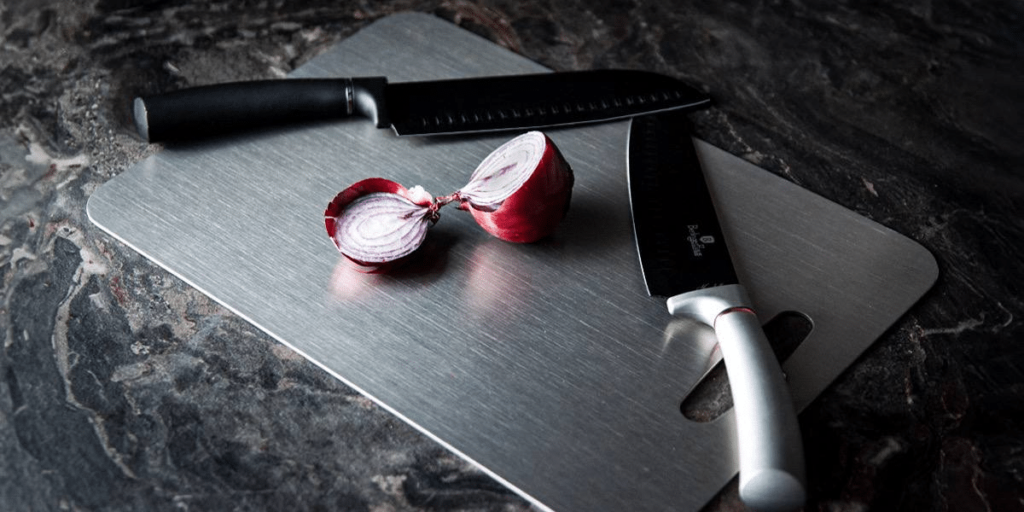In the world of kitchen essentials, choosing the right cutting board is more important than you might think. A great cutting board not only affects food safety but also plays a crucial role in knife longevity and ease of cleaning. While wood and plastic have dominated the market for years, a new contender has emerged: the Titanium Cutting Board. In this article, we’ll explore why titanium is revolutionizing food prep and why it’s the best investment for your kitchen.
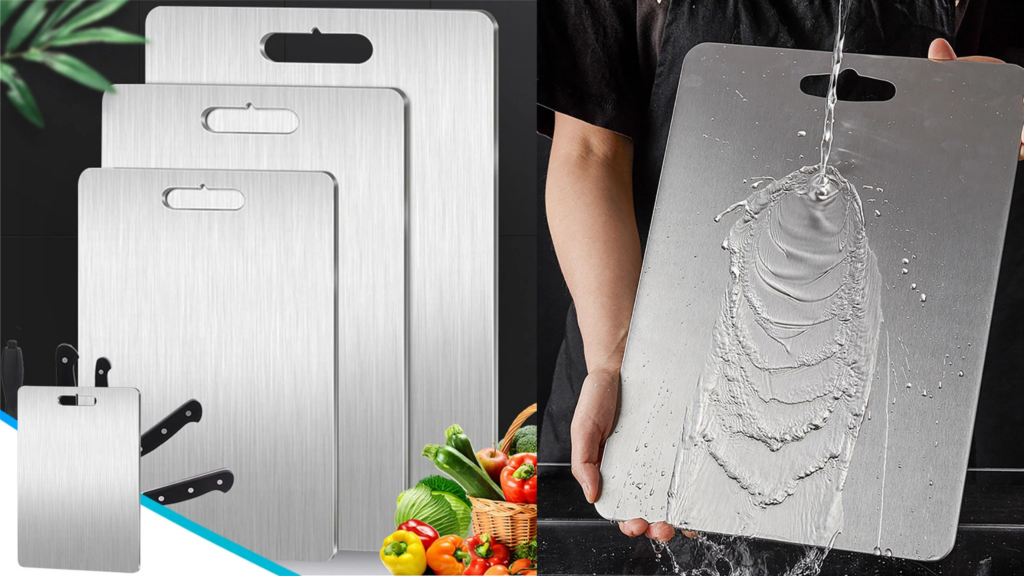
1. The Problems with Traditional Cutting Boards
For decades, wood and plastic cutting boards have been the primary choices in kitchens worldwide. While both have their benefits, they also come with notable drawbacks that make them less than ideal for modern cooking needs. As food safety and convenience become greater priorities, it’s worth considering how traditional cutting boards may fall short.
Wood cutting boards
Wood cutting boards are often praised for their natural look and durability. Many chefs prefer them because they are gentle on knives and provide a sturdy surface for chopping. However, wood is highly absorbent, meaning it can retain moisture from food, leading to bacterial growth and mould formation. This is especially concerning when cutting raw meat, as bacteria can seep into the porous surface and be difficult to remove completely.
In addition to hygiene concerns, wood cutting boards require regular maintenance to stay in good condition. Without frequent oiling, they can dry out, crack, or warp over time. Proper drying after washing is essential, as prolonged exposure to moisture can cause them to split or develop an uneven surface.
Another disadvantage is that some harder wood boards, such as bamboo, can dull knives over time. While softer woods are gentler on blades, they are also more prone to scratches and knife marks, which can harbour bacteria. Despite their aesthetic appeal, wood cutting boards may not be the most practical or hygienic option for modern kitchens.
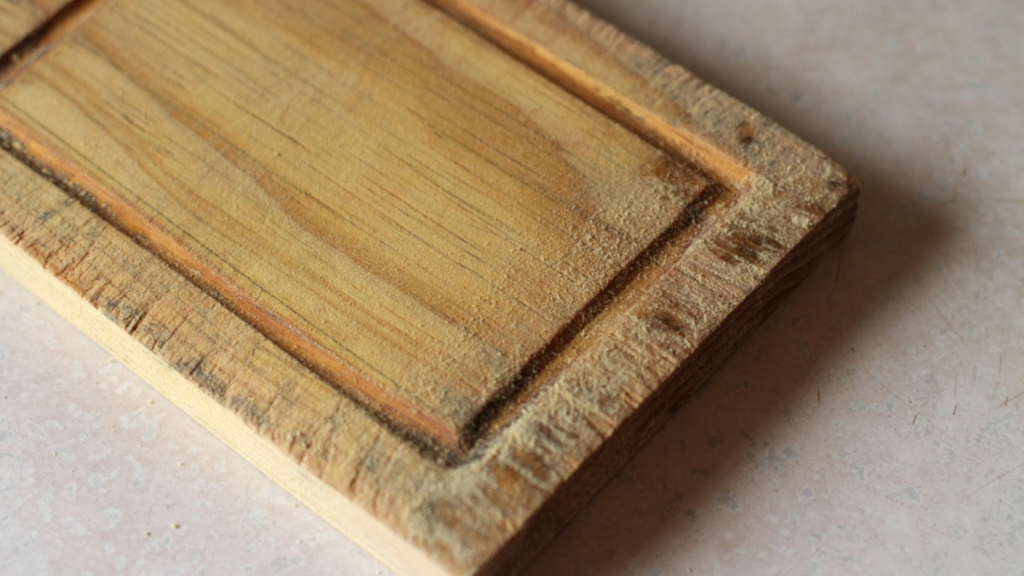
Plastic Cutting Boards
Plastic cutting boards have long been a popular choice due to their affordability and ease of cleaning. Many home cooks and professional chefs appreciate their lightweight design and dishwasher-safe convenience. However, despite these advantages, plastic cutting boards come with several significant downsides that make them less than ideal for long-term kitchen use.
One major issue with plastic cutting boards is that they are prone to deep scratches and grooves. Every time a knife slices through the surface, it creates tiny cuts that can trap food particles and bacteria. Unlike wood, which has natural antibacterial properties, plastic lacks the ability to resist microbial growth. Over time, these deep knife marks become difficult to clean, increasing the risk of cross-contamination and foodborne illnesses.
Another concern is the potential presence of harmful chemicals. Some plastic cutting boards contain toxins like BPA or phthalates, which may leach into food when exposed to heat, acidic ingredients, or repeated use. Even BPA-free plastics can degrade over time, raising concerns about their long-term safety for food preparation.
Durability is another drawback. While plastic boards are often inexpensive, they tend to wear out quickly. Regular exposure to knife blades can cause them to warp, crack, or break, requiring frequent replacements. This not only makes them less cost-effective in the long run but also contributes to unnecessary plastic waste.
Due to these limitations, many people are now turning to an innovative alternative: the Titanium Cutting Board. Offering superior durability, hygiene, and performance, titanium is redefining the standard for kitchen essentials.
2. What Makes Titanium Cutting Boards Revolutionary?
Titanium is well-known for its exceptional strength, durability, and resistance to corrosion, making it an innovative choice for modern kitchens. Unlike traditional cutting boards, a titanium cutting board offers a superior combination of hygiene, longevity, and ease of use.
One of the standout benefits of titanium is its ultra-hygienic properties. Unlike wood, which absorbs moisture and harbours bacteria, or plastic, which develops deep grooves that trap food particles, titanium is naturally antibacterial. Its non-porous surface prevents bacteria, mould, and odours from accumulating, ensuring a cleaner and safer food prep area.
Durability is another key advantage. A titanium cutting board is highly scratch-resistant, meaning it won’t develop deep cuts or marks like plastic boards. This helps maintain a smooth, sanitary surface over time, reducing the risk of cross-contamination.
Despite its toughness, titanium is designed to be knife-friendly. Unlike glass or some hard materials that can quickly dull knife edges, titanium maintains blade sharpness without excessive wear. This balance makes it an excellent choice for preserving the longevity of high-quality knives.
Another benefit is its lightweight yet durable nature. Titanium cutting boards are incredibly strong yet easy to handle, making them practical for both professional chefs and home cooks. Unlike heavy wooden boards that require careful maintenance, titanium is effortless to manage.
Cleaning is also a breeze. Titanium cutting boards are dishwasher safe and require minimal upkeep—no need for oiling or special treatments. A simple rinse with soap and water is enough to maintain their pristine condition.
With its unparalleled combination of hygiene, durability, and convenience, a titanium cutting board is an excellent investment for anyone looking to upgrade their kitchen essentials.
3. Health and Safety Benefits of Titanium Cutting Boards
One of the biggest concerns in any kitchen is food safety. Cross-contamination from raw meat, fish, and vegetables can lead to foodborne illnesses. A Titanium Cutting Board addresses these risks by offering superior hygiene benefits:
Bacteria-Resistant – Unlike wood, titanium doesn’t absorb moisture, preventing bacterial growth and keeping your cutting board hygienic. Its non-porous surface ensures that food particles and liquids don’t seep in, reducing the risk of cross-contamination. This makes titanium an ideal choice for maintaining a cleaner kitchen environment, especially when handling raw meats, seafood, and fresh produce. With titanium, food prep is safer and more sanitary. Unlike wood, titanium doesn’t absorb moisture, making it impossible for bacteria to grow.
Easy to Sanitize – A simple rinse or dishwasher cycle is all it takes to keep a titanium cutting board clean. Its non-porous surface prevents stains, odours, and bacteria buildup, ensuring effortless maintenance. Unlike wood or plastic, titanium requires no special care, making it a hassle-free and hygienic choice for any kitchen.
No Chemical Leaching – Titanium is a safe and non-toxic material that won’t release harmful chemicals into your food. Unlike plastic cutting boards, which may leach toxins over time, titanium remains stable even with heavy use. This makes it a healthier and more reliable choice for food preparation in any kitchen.
For families, professional chefs, and health-conscious individuals, this makes titanium the safest cutting board option available.
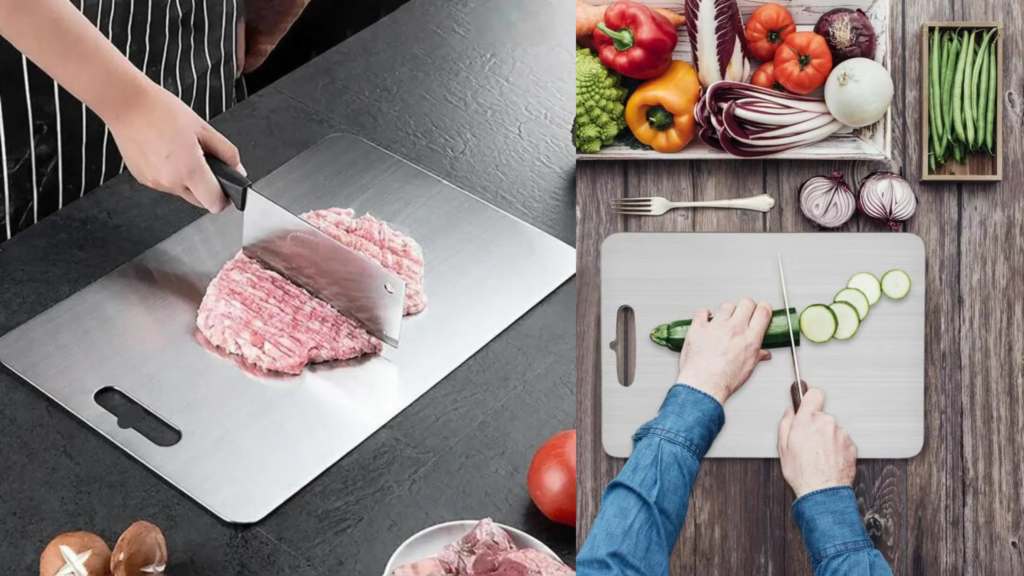
4. Why Titanium Cutting Boards Are the Best Investment for Your Kitchen
While the Titanium Cutting Board may have a higher initial cost compared to wood or plastic, its benefits make it the best long-term investment. Here’s why:
Cost-Effective in the Long Run – A titanium cutting board is a long-term investment that outperforms plastic alternatives. While plastic boards wear out, crack, and need frequent replacements, titanium remains durable and reliable for years. Its longevity saves money over time, making it a cost-effective choice for both home cooks and professional chefs.
Eco-Friendly – Titanium cutting boards help reduce plastic waste by lasting a lifetime, eliminating the need for frequent replacements. Their durability makes them an eco-friendly choice for a more sustainable kitchen.
Durable & Damage-Resistant – Titanium cutting boards are built to last, resisting cracks, warping, and deep scratches. Unlike wood or plastic, they maintain their integrity over time, ensuring a reliable and long-lasting surface for food preparation.
When considering overall value, titanium cutting boards far outperform traditional options. Their durability, hygiene, and long lifespan make them a superior investment, eliminating the need for frequent replacements and ensuring a safer, more efficient food prep experience.
5. How to Choose the Right Titanium Cutting Board for Your Needs
When selecting a Titanium Cutting Board, consider the following factors:
Size & Thickness – Choose a size that fits your kitchen space and cooking needs.
Additional Features – Look for options with anti-slip edges, juice grooves, or dual-sided designs.
Ease of Maintenance – Ensure it’s dishwasher safe for easy cleaning.
6. ChopChop USA Titanium Cutting Board – The Ultimate Choice for Your Kitchen
When it comes to premium quality and innovation, ChopChop USA is the best place to buy a Titanium Cutting Board. Here’s what makes their boards stand out:
Premium-Grade Titanium – Scratch-resistant, ultra-hygienic, and built to last.
Designed for Home Cooks & Professionals – Perfect for all types of food prep.
Sustainable & Eco-Friendly – Reduces plastic waste while offering superior performance.
Highly Rated by Customers – Trusted by thousands for its durability and safety.
Get your ChopChop USA Titanium Cutting Board today: ChopChop USA Titanium Cutting Board
Upgrade your kitchen today with a ChopChop USA Titanium Cutting Board and experience the future of food prep!
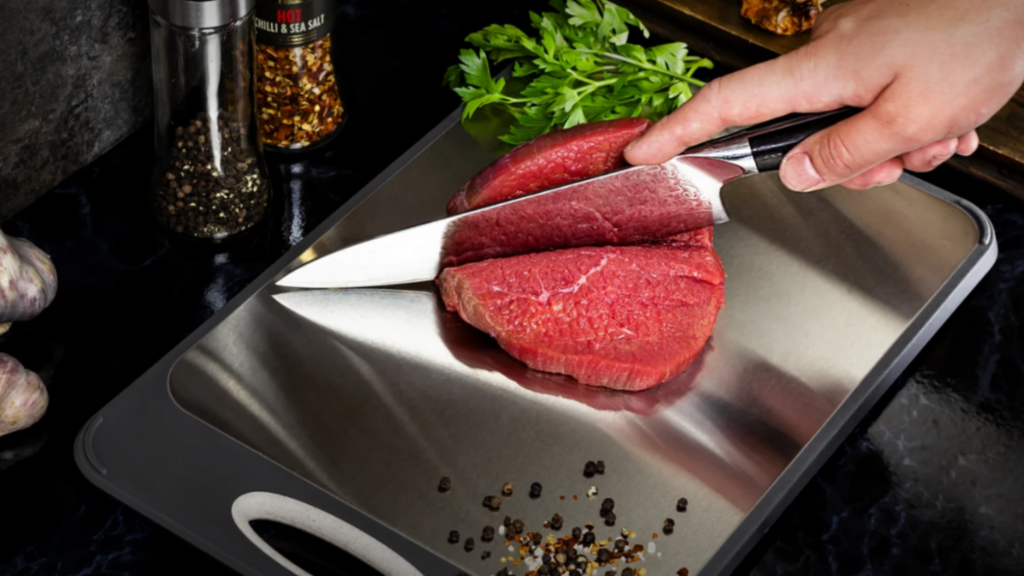
Conclusion
Traditional cutting boards may have served us well, but they come with limitations that affect hygiene, durability, and food safety. The Titanium Cutting Board is the perfect solution, offering a bacteria-resistant, knife-friendly, and long-lasting option for modern kitchens.
If you’re ready to invest in a cutting board that lasts a lifetime, look no further than ChopChop USA. Make the switch today and experience the future of cutting boards!
Order now: ChopChop USA Titanium Cutting Board

